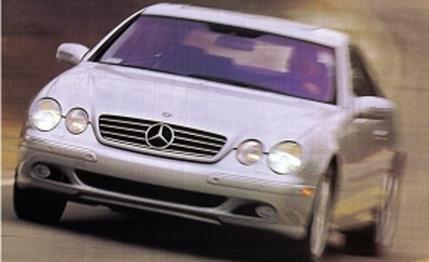
 Road Test
Road Test
If you are a committed auto enthusiast and you can afford to park a new Mercedes-Benz CL500 alongside your BMW M5 and the Porsche 911 Turbo that's on order, you owe it to your kinfolk in the global fraternity of car nuts to step up and buy one (it starts at just $89,550). Think of it as a civic duty. This car advances the art and science of automotive technology significantly, and the performance, weight-reduction, and convenience features it showcases will only trickle down to benefit us, the proletariat, if you rich folks blaze the trail by buying lots of CL500s.
Sorry, there's no tax deduction or Rotary Club award for supporting this worthy cause, but trust us --the aesthetic and sensual rewards of ownership are ample. Just gaze on retired Benz design boss Bruno Sacco's final masterpiece. Gorgeous. The only pillarless hardtop in production, this CL is no mere S-class two-door. Climb inside and bask in the warmth of its distinctive and friendly interior --made all the friendlier if equipped with the optional $1103 multicontour seats, which use pulses of air in four lumbar chambers to massage the lower back. (See what we mean? Don't mom-'n'-pop Taurus owners deserve a back rub, too?)
But what you rich folks will really love, and what we regular folks are champing at the bit for, is Active Body Control (ABC). Mercedes touts it as a world's first, but it is arguably a big improvement on the technology used on the Infiniti Q45a from 1991-95. That system didn't quite live up to its promise and there weren't enough takers at $5000 a pop to warrant further development, so it died out. ABC comes standard on all CLs and will likely be extended to the S-class and other top-drawer Benzes soon.
As did the Q45a, the CL employs coil springs to bear the normal load of the car and augments them with hydraulic plungers that can push down but cannot pull up a wheel. (That is to say, both systems are technically semiactive suspensions.) The improvements are largely due to advancements in fluid-handling and control technologies. The Infiniti's system was only capable of counteracting inputs of one cycle per second or slower, and it didn't function over the entire range of suspension movement. It was tailored more for ride, and it could be tripped up in slalom or emergency maneuvers. (The suspension would still be trying to zig while the car was zagging.)
The Mercedes system operates throughout the range of wheel travel and at up to five cycles per second -- plenty quick enough for slalom or lane-change maneuvers. The CL system's operating pressure is higher than the Q's (2900 vs. 1500 psi); weight is also down about 55 percent to 88 pounds, although the power drain is similar -- between 1 and 7 hp. Cost is still top-secret.
Here's how it works: Say you're driving along and slam on the brakes. The car's weight shifts forward, the front coil springs compress, and the rear ones uncoil, as in a normal car. But instead of the body's diving, ABC pumps up the hydraulic cylinders above each front spring and relaxes the ones in back so the car stays level. The same happens in cornering, except the computer can fine-tune how much it pumps up the front and rear outboard cylinders to maintain safe neutral or understeering handling behavior. In this way, the system acts like anti-roll bars with infinitely variable stiffness. Speaking of which, ABC negates the need for anti-roll bars (unlike the Q45a system), which greatly improves ride over single-wheel bumps.
ABC provides automatic load leveling and can raise the car (via a dash-mounted switch) for traversing rough roads. It also lowers the car to improve aerodynamics at speed. A sport mode permits less (virtually zero) body roll, pitch, and dive and increases steering effort somewhat. Because the shock absorbers are relatively soft and completely separate from the ABC system, activating the sport mode does not compromise straight-line steady-speed ride quality at all. We found the sport mode comfortable while commuting over Michigan's Belgian blocks.